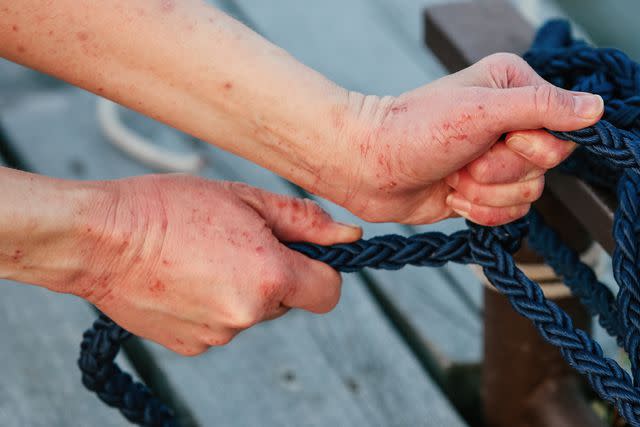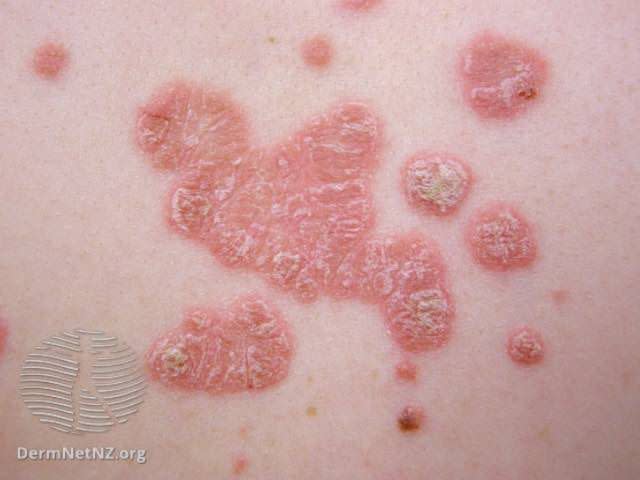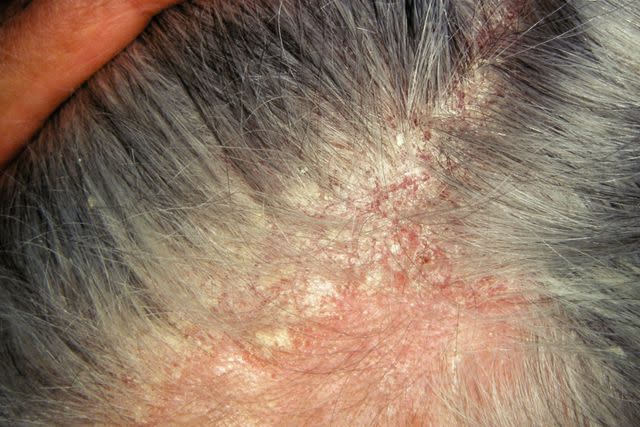Why Is My Skin So Dry?
Causes and How to Get Rid of Dry Skin
Medically reviewed by William Truswell, MD
Dry skin may cause scaling, cracking, and discomfort. Although dry skin is often noticed on the face, hands, legs, and feet, it can develop anywhere.
Dry skin has many potential causes, including aging, your environment, bathing habits, soaps, medications, and underlying health conditions. You can often take steps at home to treat and prevent dry skin, but you may need to see a healthcare provider if those steps don't provide relief.
This article will cover the symptoms of dry skin, types of dry skin, common causes, and how to get rid of dry skin.

Elena Popova / Getty Images
Dry Skin Symptoms
Dry skin can cause several symptoms, including:
A rough skin texture
Cracking in the skin, which can bleed if deep
Pain where the skin is itchy
Peeling of the skin
A stinging or burning feeling in the skin
Infections, which can occur from scratching or from broken skin that allows germs to enter
Wrinkled, loose skin
Types of Dry Skin
Certain skin conditions are known to cause dry skin. Here are some of them.
Eczema

Reproduced with permission from ©DermNet NZ www.dermnetnz.org 2022
Eczema is an inflammatory skin condition associated with:
Blisters
Dry skin
Skin infections
Rough skin patches
About 31 million Americans have eczema, according to the National Eczema Association. Eczema can present in infancy, childhood, or adulthood.
Psoriasis

DermNet / CC BY-NC-ND
PsoriasisPsoriasis is a disease that causes raised plaques and scales on the skin. Although the cause isn't clear, it's related to inflammation and the immune system not working as it should.
The raised areas of skin most commonly appear on the:
Elbows
Knees
Scalp
In addition to dry, itchy skin, other symptoms of psoriasis include swelling and joint stiffness.
There are more than 7.5 million adults with psoriasis in the United States.
Seborrheic Dermatitis

Reproduced with permission from © DermNet New Zealand www.dermnetnz.org 2023.
Seborrheic dermatitis is a condition that causes inflammation of the skin's upper layers. In infants, it's often referred to as cradle cap. It can occur in adulthood as well. Its milder form is referred to as dandruff.
Symptoms associated with seborrheic dermatitis include:
Dry or greasy scales on the scalp
Scalp itchiness
A yellow or red scaly rash on the scalp or head
Hormonal changes and cold weather can make seborrheic dermatitis worse.
What Causes Dry Skin?
Dry skin can have many potential causes. Sometimes, the cause is obvious. Other times, the cause of your dry skin is unclear.
Here are some potential causes of dry skin:
Age: It's normal for the skin to become drier over time, especially after age 40.
Cold, wintry weather: The cold, indoor heating, and low humidity can dry out the skin.
Taking long or hot showers or baths: Longer time in a hot shower or bath can dry skin.
Soaps and cleansers: Using soaps or harsh cleaners that remove oil from the skin can dry it.
Using certain medications: Medications such as diuretics (water pills), statins (drugs that treat cholesterol), isotretinoin (an acne treatment), and antacids can lead to dry skin.
Getting treated for cancer: Dry skin can be a side effect of cancer treatments such as chemotherapy and radiation.
Receiving kidney dialysis: Dialysis removes extra moisture from your body.
Dry Skin in the Winter
Even if you rarely have dry skin, you may find you have some dry areas in the wintertime. This is because the humidity is often lower in the winter months, both outside and indoors when using heating. Wintertime dry skin can happen to people of all ages, no matter what their usual skin type is.
You may get by with using lotion to moisturize your skin most of the year, but in the winter, you may have to switch to an ointment or cream for dry skin. Ointments and creams are more effective at treating dry skin.
Risk Factors for Dry Skin
Certain risk factors can increase the chance that you may develop dry skin. Those include:
Being over the age of 40 (after age 40, your body produces less sebum, an oil that keeps the skin soft)
Being positive for human immunodeficiency virus (HIV)
Having anything other than medium skin tones
Having certain chronic health conditions, like diabetes or thyroid disease
Having certain skin conditions that are associated with very dry skin (such as eczema and psoriasis)
Having certain nutrient deficiencies, including vitamin D, vitamin A, niacin, zinc, or iron
Smoking
Dry Skin Complications
Dry skin is usually treatable and not serious. One potential complication is the risk of infection. This could happen because the cracks created by dry skin can permit bacteria or other organisms to enter.
Another potential complication of dry skin is itching or thickened patches of skin if you have dry skin for a long time.
Dry skin won't lead to a chronic health condition, but dry skin is a common complication of certain conditions. These include diabetes, thyroid disease, and psoriasis.
How to Get Rid of Dry Skin
Dry skin can cause discomfort, so you will most likely want to find relief. Many moisturizing choices are available, with ointments and creams usually being more effective and less irritating than lotions.
Moisturizers to Treat Dry Skin
Thicker ointments or creams should help dry skin more than thinner ones. Look for an ointment or cream that contains at least one of the following:
Dimethicone
Petrolatum
Related: The Best Editor-Tested Moisturizers for Dry Skin
Is Vaseline Good for Dry Skin?
Also called petrolatum or petroleum jelly, Vaseline historically has been an inexpensive way to help dry skin. Apply Vaseline when your skin is damp, like right after you bathe or shower. If you have acne-prone skin, avoid using Vaseline on your face. It may lead to more breakouts.
Lifestyle Measures to Treat Dry Skin
Other measures you can take to treat dry skin can include:
Look for fragrance-free skin care products: Fragranced products may be too irritating for dry skin. Note that fragrance-free and unscented are not the same thing. Unscented products may have chemicals that hide odors, and those chemicals can still bother the skin. They can also remove oils that help the skin.
Use warm (not hot) water in baths and showers: Limit your bathing time to five to 10 minutes to lower your exposure to water temperature that may dry out the skin.
Use your ointment or cream immediately after bathing or washing your hands: After bathing is the ideal time to retain the existing moisture on your skin. To cut down on a greasy look or feel, put the product in your hands and rub it in until your hands and the affected area no longer feel greasy.
Run a humidifier, if needed: If you live or work in an area with low humidity, you may need a humidifier to add more moisture to the air. In addition to portable humidifiers, you can find out if your home heating system has a humidifier.
Identify dry skin triggers: Note whether certain soaps or fabrics seem to trigger dry skin.
Preventing Dry Skin
If you know you're prone to dry skin or if you want to stop dry skin problems before they occur, consider taking the following preventive measures:
Use moisturizer daily.
Stick with short, lukewarm showers or baths, and pat dry afterward rather than rubbing the skin.
Avoid sitting near drying heat sources (like fireplaces).
Use fragrance-free skin products.
Drink plenty of water, which will benefit your whole body.
Shower after swimming to remove irritating pool chemicals.
When to See a Healthcare Provider
If your skin continues to itch and feel irritated even after using over-the-counter products, it's time to see a healthcare provider. This may include a dermatologist (a specialist in skin conditions).
It could be that you need a stronger product to help your dry skin. Your dry skin may also be a sign of a chronic skin condition or other medical condition that needs treatment.
A healthcare provider may take these steps to diagnose the cause of dry skin:
Your medical history and family medical history
Your report of symptoms, including the type and location of dryness
Your medications, environment, and bathing and grooming habits
Skin examination
If underlying issues are suspected, they may do further tests:
A skin biopsy (taking a tissue sample to examine in the lab)
Blood tests for disorders like diabetes, kidney disease, or low thyroid
Summary
Dry skin can cause scaling, cracking, and irritation. It results from aging, cold weather, taking certain medications, and having certain chronic conditions. You're more prone to dry skin if you are over the age of 40, have black or brown skin (or fair skin), and if you smoke.
Some ways to get rid of dry skin include applying ointments or creams (regularly and also after you bathe) and using fragrance-free skin products. You should see a healthcare provider, like a dermatologist, for dry skin if you try over-the-counter products and still have dry skin irritation or concerns.
Read the original article on Verywell Health.

